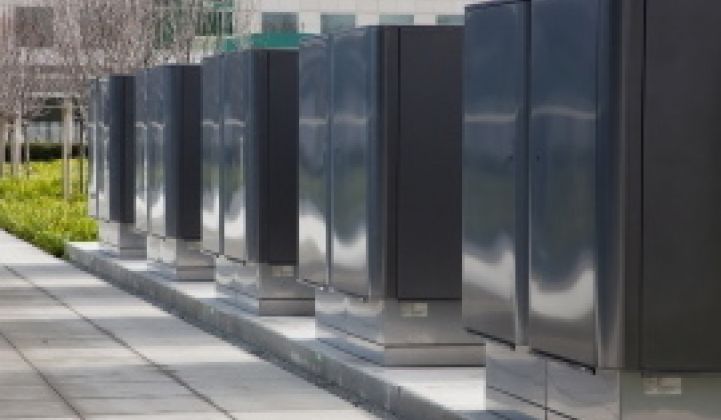Silicon Valley fuel cell startup Bloom Energy has gotten approval for its biggest project yet -- and Delaware utility customers will help foot the bill. On Tuesday, Delaware regulators approved a plan to bill customers of utility Delmarva Power to build a factory for Bloom’s natural gas-powered fuel cells, along with installing 30 megawatts of its Bloom Boxes in the state.
It’s quite a coup for Bloom, not the least because of all the public money that’s going to the project. Delmarva plans to raise more than $100 million over 20 years to help finance the project, which equates to a $1.34-per-month surcharge on customer bills. Delaware is also providing $18 million in state incentives, and the project is seeking a federal cash grant for renewable power projects.
Not bad for a startup that’s raised more than $600 million in venture capital and has high-profile backers like Kleiner Perkins partner John Doerr and former Secretary of State Colin Powell on board. Its most recent round of $150 million came with a valuation of $2.7 billion for the company, according to Fortune.
But can Bloom’s fuel cells compete with the natural gas-fired power plants that now serve the grid? That’s a complicated question, involving differences in cost per watt (gas turbines are still cheaper), the cleanliness of emissions (Bloom’s fuel cells are much cleaner, though they still emit CO2), the potential to capture waste heat for extra benefit (Bloom’s fuel cells don’t, while other gas-fired systems do), and the extra-complicated question of whether or not Bloom’s fuel cells are a “green” energy source. Bloom will have to address all these questions if it wants to crack open the long-awaited, still-nascent fuel cell market.
The Tuesday decision by the Delaware Public Service Commission opens the door for Bloom Energy to start raising funds to finance the project. The 30-megawatt project, which could grow to as much as 50 megawatts, is an order of magnitude larger than Bloom’s biggest projects so far, with California customers such as Google, eBay, Adobe and AT&T, as well as Bloom’s pilot projects with California utilities Pacific Gas & Electric and Southern California Edison and Tennessee’s EPB.
Bloom hasn’t put a price tag on the project yet, but it has touted the potential economic benefits for Delaware -- up to 900 jobs at its factory and an estimated $300 million in annual economic activity. That’s boosted project backers against critics who worry that Bloom’s projects won’t come off in time or on budget. One conservative critic has testified that the cost to Delmarva ratepayers could reach as high as $3 to $4 a month if Bloom and the utility can’t maximize the value of their “Bloom Electrons” in markets for renewable power. For its part, Bloom has agreed to pay Delaware a fine as high as $41 million if it fails to build the factory -- a move one commissioner said was critical to Tuesday’s approval.
Delaware lawmakers also redefined natural-gas fuel cells as renewable power this summer, both to allow Delmarva to claim the project to help it meet state renewable energy mandates and to help Bloom gain access to markets for green power.
That’s an interesting move, given that natural gas isn’t exactly a renewable resource. While Bloom’s solid oxide fuel cells emit far fewer pollutants than do natural gas-fired turbines, they still emit carbon dioxide, a greenhouse gas -- and they still have to buy their fuel on the fluctuating natural gas market. By all measures, combined-cycle natural gas turbines are still far cheaper than fuel cells when it comes to cost per watt, though Bloom says that it can reach grid parity with subsidies.
Part of that subsidy scheme involves Bloom’s use of a source of renewable natural gas -- biogas, the methane that comes from rotting organic material. Because biogas projects capture gases that would otherwise add to the atmosphere’s global warming problem, they’re considered carbon-neutral.
Bloom and Delmarva haven’t made clear whether biogas will be part of their plan in Delaware. But about half of Bloom’s projects in California now get credited for running on so-called directed biogas, even though many of those projects aren’t actually using biogas. Rather, Bloom has contracted to buy biogas from landfill projects in other states to get the California credit.
California regulators recently proposed changes to the state’s Self-Generation Incentive Program (SGIP) that could put an end to such out-of-state biogas credits, although it won’t apply to projects already underway. Given that the old rules gave biogas projects almost twice as much subsidy money as non-biogas sources, that’s a big deal -- Bloom received $218.5 million in SGIP subsidies in 2010, nearly two-thirds of the total given out by the program that year.
Another big question for Bloom is why it has foregone a potential side benefit that many other fuel cell makers are touting: the ability to capture waste heat for extra power. While most fuel cells emit a lot of heat, Bloom’s are built to run cool.
That makes them easier to install and maintain (and safer to house at customer premises), but it also means that they can’t capture the benefits of cogeneration, or catching heat to make power generation more efficient or supply it to other building systems. Fuel cell makers like ClearEdge Power and FuelCell Energy, on the other hand, make use of their combined heat-and-power characteristics, and even traditional natural gas-fired turbines can be built to make use of waste heat.
It will be interesting to see how Bloom’s factory and 30-megawatt project proceed with financing amidst all these questions. They’re certainly the biggest opportunity and challenge yet for the high-flying startup. Whether Bloom can rise to the challenge of being both green and cost-competitive remains very much an open question, however.



